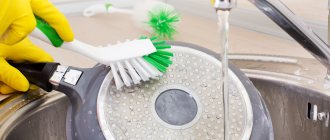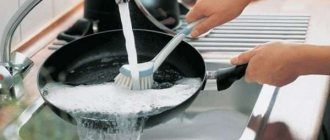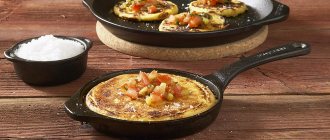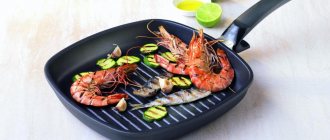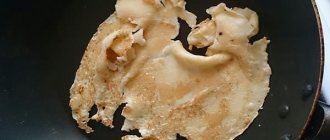A frying pan is one of the main kitchen utensils. Every housewife has a whole set of frying pans - pancake, grill, small, large. They are made from different materials and require constant care. Restoring the non-stick coating is the main concern of owners. High-quality cookware in good condition will help you always prepare healthy, tasty food.
What happens if you eat non-stick coating?
Teflon, one of the most popular non-stick coatings, is indeed not harmless. If the exposure temperature recommended by the manufacturer is exceeded, or the coating is damaged, then its use will be truly dangerous; harmful substances, including carcinogenic ones, will begin to be released.
Interesting materials:
Is it possible to restore contacts after a factory reset? Is it possible to recover a micro SD card? Is it possible to restore muscles? Is it possible to restore unsaved changes in Word? Is it possible to restore a patent if it has been revoked? Is it possible to restore correspondence on Skype? Is it possible to restore correspondence on WhatsApp? Is it possible to restore a shrunken wool item? Is it possible to restore a wool item? Is it possible to recover a screenshot?
Why does the frying pan burn?
Cooking can become very difficult if the pan burns. What should you do when the potatoes burn and stick to the bottom, you can’t get the scrambled eggs off the frying pan, and you end up with ugly lumps instead of pancakes? This problem can most often be dealt with, but the solution will vary depending on the material from which the pan is made.
Let's look at ways to clean the surface and restore the non-stick coating for different types of frying pans and pots.
If your cast iron skillet burns
What to do in this case? A cast iron frying pan is made of porous materials. The oil enters the pores and creates a natural non-stick coating. Violation of this coating leads to burning. To avoid this and restore the protective coating, you need to perform the following treatment:
- Wash the dishes with warm water and wipe dry.
- Cover the bottom of the dish with salt and heat in the oven or on the stove. Processing time is one hour.
- Add salt. Rub the inner surface of the dish with sunflower oil.
You must act carefully when using oven mitts. The temperature of cast iron after calcination is very high. But if, despite the preparation, everything sticks to the pan. What to do in this case? You can heat the pan again. First you need to wash it thoroughly and clean the burnt layer. Then wipe and rub with sunflower oil inside and out and, removing excess oil, place in the oven with the bottom up. It needs to be heated for about an hour at a temperature of 180°. After cooling, the dishes can be removed from the oven. This procedure will have to be repeated from time to time to restore the non-stick layer.
Interesting things about Teflon
Teflon, in fact, is a cold and heat-resistant plastic with special physical and chemical properties, and is widely used not only for kitchen utensils and utensils.
In Russia it is called fluoroplastic.
The material is patented, and the word “Teflon” itself is registered by the American company DuPont as a trademark.
Teflon glides better than melted ice; thanks to this property, mechanical parts that do not require lubrication are made from it.
Teflon, along with titanium, is biologically very compatible with the human body. Therefore, in ophthalmology, surgery and dentistry it is used to make implants.
Teflon is an excellent protection against insects; they are not able to crawl on vertical surfaces on which this substance is applied.
Restoration of Teflon coating
Our prices (the cost of coating is indicated for 1 product)
REGULAR AND PANCAKE PANS
REGULAR POTS AND SAUTS
ROASTERS, LARGE PATS
ELECTRIC GRILL PLATES
BAKING Molds with Spatula
OTHER PRODUCTS
ATTENTION: For technical reasons, our Workshop does not provide services for dismantling plastic and wooden handles, bearings and heating elements from dishes!
(we recommend dismantling the handles yourself)
DISASSEMBLY / INSTALLATION OF HANDLES
DISASSEMBLY / INSTALLATION OF MECHANISMS
DISASSEMBLY / INSTALLATION OF HEEATERS
We specialize in the application and repair of non-stick coatings on a variety of products. In addition to repairing kitchenware coatings, we take on orders from bakeries and confectionery chains, and also work with enterprises that use fluoropolymer coatings for industrial purposes. We try to help our customers and carefully return their products, tools and equipment to their original appearance.
Accepting orders near the metro!
Below are examples of our work that deserve your attention. Assess the condition of the products BEFORE and AFTER restoration of the non-stick Teflon coating.
Restoring the non-stick coating of a grill pan
The TEFAL grill pan has not been used in the kitchen for a long time, but our clients felt a pity to throw it away. After our work on restoring the non-stick coating, dozens more steaks will now be cooked on it!
Restoring the non-stick coating of a multicooker bowl
Our clients' reliable Toshiba cast iron bowl became unusable over time due to deterioration of the non-stick properties of the coating and slight corrosion on the bottom. We were able to help get her back on track!
Repairing the non-stick coating of a large frying pan
At the request of a large Moscow confectionery chain, we carried out work to restore the non-stick coating of Italian RISOLI induction frying pans.
Teflonation of a pastry mold for frying eggs
Especially for our clients, we demonstrated the aesthetic possibilities of a three-layer non-stick decorative coating on a pan for frying eggs.
Applying a non-stick coating to an aluminum baking sheet
For one of our clients who specializes in baking croissants, we completed an order to apply a non-stick silicone coating to DeBuyer French pans.
Reviews about our work
“Guys, thank you so much. You guys are great, keep it up! Thank you for the bowl - everything is fine and good - it doesn’t stick, doesn’t burn, I’m happy with everything. I’ll gather my strength and bring the bread machine for restoration.”
“Very disappointed Bork, but you gave my multicooker a second life! Thank you! There was also a gift upon receipt of the bowl and, in general, incredibly pleasant and prompt communication and service! Keep it up)"
“The coating is fine. My wife was boiling milk in a pressure cooker. Burnt. The burnt film surfaced. Didn't stick to the new Teflon. Super!"
Coating is applied in strict accordance with technology under production conditions.
The non-stick coating restoration process includes the following key steps:
In our work, we use modern fluorine-containing polymer materials for food and industrial use, produced both in Russia and abroad.
Our coatings have excellent performance and consumer characteristics, are safe for health, and are also certified for use in the Russian Federation.
Moscow, Avtozavodskaya metro station, st. 7th Kozhukhovskaya, 9
Book of ideas, complaints and suggestions
Six Secret Rules for the Longevity of Nonstick Coatings
1) The coating should not be subjected to abrasive mechanical influences (cleaning powders and abrasives, metal or metallized brushes/spatulas/devices/tools, etc.).
2) Operation of the coating should be carried out using polymer and wooden blades/devices/tools.
3) To wash the coating, you must use soft polymer sponges and detergents intended for tableware.
4) The coating should not be heated to more than +240 degrees. Celsius, as well as temperature changes: from the stove - under cold water, from the refrigerator - directly to the stove, etc.
5) Coated products must be used for the intended purpose specified by the manufacturer of the product.
6) When using a coated product or after washing it, it is recommended to lubricate the surface of the coating with a small amount of vegetable oil.
Fluoroplastic emulsion (Adgelast, etc.)
The question of the coating remained, I began to fantasize and remembered Teflon, went online and found a domestic manufacturer in the Moscow region. The product is called Adgelast. After talking with competent comrades from the sale of balo, it was found out that: it costs 450 rubles / kg; applied with a spray gun to a sandblasted surface; As a result, we get a container with the walls of a frying pan, i.e. maximum slippery non-stick non-stick with operating conditions up to 260*C. There is one “BUT”. After application, you need to place it in a place where it is 420*C for a few minutes. Send any quantity anywhere in the country through agencies. Quarter, 22 Oct. 09, 21:39
CJSC Stupinsky Chemical Address: 142800, Moscow region, Stupino, st. Frunze, possession 9/14 Contacts: 8-928-137-29-58 Galina Emelyanovna Andreichikova - chief technologist for materials and coatings (49664) 2-64-00 Anatoly Petrovich Kuznetsov - deputy general director Email www.cxz.ru
— sent a request there. this time the reaction was quick, but still no use, because... they began to talk about “close cooperation”, find out “why do you need it”, say that the application technology is very complicated and offer an internship at their factory.
They say, come close to the pipe, we will apply a coating on it with any specified properties. They told me the price was 80 thousand rubles, I was completely blown away. When I asked to sell 5 liters of liquid composite, they responded with a veiled refusal, saying that without being sure that I could follow the correct application technology, they would not give me anything. So apparently we need to look for other options.
Alternative methods
There are alternative recovery methods without your direct participation. First, you can contact a company or service that specializes in Teflon coating of pans and pots. These companies usually know how to treat worn or damaged Teflon pans. You may have to spend some extra money, but you are guaranteed to get a satisfactory result that will make your pans look like new.
Another way is to contact the manufacturer. Reputable companies that make high-quality pans usually provide a warranty that can help with repairs and refinishing. Some companies may offer to remake the pan without you having to pay for it. Some may ask you to pay, but you can get a professional and satisfactory result. It is important to clarify the type of cookware you need to tidy up - ceramic or aluminum frying pan.
Ceramic
Frying pans with ceramic coating appeared not so long ago, but they have already collected a lot of positive reviews from housewives. This is due to the fact that the ceramic coating not only has non-stick properties, but is also completely safe for humans.
When heated, the ceramic surface does not emit harmful substances and does not interact with food. But there is one drawback - it is impossible to restore the non-stick coating on such a frying pan. Therefore, if food starts to burn on it, you will have to replace the frying pan with a new one. In order for a ceramic frying pan to last longer, it should not be exposed to heat.
The secret of potatoes
And just recently I learned about another effective way to return a non-stick coating to its former appearance and functionality. Regular potatoes will help. I use it as a detergent. I simply cut the tuber in half and rub the base of the pan well with it.
The fact is that fresh potatoes contain a lot of acids: 4-O- and 5-O-caffeoylquinic, 3,4- and 3,5-dicaffoylquinic, natural oxalic. These substances, when combined, can form Teflon. Thus, by wiping the surface of the cookware with potatoes, it is quite possible to renew the non-stick layer. And natural oxalic acid can dissolve rust even on the outer part of the frying pan.
These are the simple ways to return expensive dishes not only to their presentable appearance, but also to their functionality.
Application and restoration of Teflon coating (PTFE application)
Application of non-stick anti-adhesive Teflon coating
(Teflon coating, or as it is scientifically called “PTFE” - polytetrafluoroethylene or fluoroplastic) on almost any materials and surfaces of products made of aluminum and its alloys, steel, cast iron, etc. (imported raw materials are used).
Applications of Teflon coatings (PTFE)
Application of Teflon (Teflonization) can be performed for the following parts and equipment:
- baking and confectionery industry: molds, baking sheets, baking sheets for buns, cookies, baguettes, croissants, making pizza; molds for making chocolate, sweets, kozinaki, etc.;
- meat and dairy industry: thermal plates and thermal knives;
- refrigeration industry: anti-adhesive materials in low temperature zones (semi-finished products, fresh frozen dough, dumplings, pizza, etc.);
- medical equipment: containers for transportation and storage of frozen organs and blood plasma;
- duplicating, flexographic and office equipment: shafts and rollers of duplicating machines;
- packaging equipment: knives for welding thermoplastic plastics;
- molds for forming products from thermoplastic plastics, foamed polystyrene and rubber;
- textile industry: on shafts;
- woodworking industry: end surfaces of cutters and circular saws;
- welding mirrors for welding polyethylene and polypropylene pipes.
Teflon coating is carried out industrially, which includes several step-by-step technological processes. The selection of the type of Teflon coating and the mode of its application is carried out taking into account the functional purpose of the product (part) and its operating conditions.
Main types of coatings:
- two-layer PTFE coating;
- PFA powder coating;
- ceramic coating "CERAM".
The main advantages of Teflon
coating (PTFE)
- heat resistance from -150°С to +300°С (short-term up to +350°С);
- high anti-friction, anti-adhesive and dielectric properties;
- high chemical and biochemical resistance;
- biological inertness (Teflon is harmless to the body).
It is possible to restore used Teflon coating, including on products with complex geometric shapes.
The cost and lead time of the order depends on the area of application of the product, its geometry, weight and material. Agreed upon at the ordering stage.
Non-stick Teflon coating ( PTFE) – we apply and restore Teflon on parts and products
As a rule, during the operation of parts and products coated with a non-stick layer, its integrity plays an important role. With intensive use, wear of this layer occurs, and the part begins to lose its functional properties (adhesion increases - “sticking”). It is necessary to replace the part with a new one, investing in its cost. An alternative to this investment is to replace the non-stick layer (reconditioning the Teflon) instead of replacing the part. If you simply re-coat the surface of the part with Teflon (using a special restoration technology), then the original properties and functions of the part will be significantly restored.
Our company will help you restore the non-stick Teflon coating (PTFE - polytetrafluoroethylene or fluoroplastic) on the metal surface of various parts and products (heating elements, welding knives, molds, stamps, etc.) in order to reduce the cost of repairs and modernization of your production , and also coat new parts and products with Teflon (non-stick Teflon coating) to give them anti-adhesive and non-stick properties.
Cheesecake baking trays - CERAM coating
Main properties of Teflon coating:
— heat resistance from -150°С to +300°С (short-term up to +350°С); — high antifriction, antiadhesive and dielectric properties; — high chemical and biochemical resistance; — biological inertness (contact with food products).
Non-stick coating - developed on the basis of polytetrafluoroethylene (PTFE) polymer, this is an inert material with properties close to those of noble metals and the ability not to enter into chemical reactions with a large number of aggressive environments, non-toxic.
Main characteristics of non-stick coatings:
-heat resistance (non-stick surfaces retain integrity when heated to 300°C); -high resistance to abrasion; - ease of cleaning.
The non-stick coating does not have high surface strength and is susceptible to mechanical damage, so it is not recommended to use metal objects when cleaning the surface with a non-stick coating.
How it works
The non-stick layer is made of polytetrafluoroethylene (-CF2-CF2-)n (Teflon). This is an extremely flexible compound that cannot degenerate even when boiled. And milk contains casein protein. When exposed to high temperatures, it creates a coating on the surface of the pan. As a result, the durability of Teflon is restored.
Now I use non-stick pans for a long time, repeating the procedure with milk periodically. This is how easy it is to save money on buying new cookware.
Improper hand washing
Even the most expensive and branded frying pan becomes greasy over time. And if at first all you need to clean is just a soft sponge and a drop of detergent, then after a month or two you already want to rub the frying pan with something hard.
To wash these pans, I recommend using only the soft/hard side of the sponge, as well as kitchen brushes. If you use them while the frying pan is hot (intensively warm), and pour water over the burnt “horror” for a couple of hours, they will cope. But metal springs will only scratch and damage the inside of the frying pan (yes, don’t buy them, even if your neighbor washes her Teflon with them and she has “nothing”).
It also matters what kind of chemistry you use. It is best to take liquid products. Loose can leave micro scratches that will grow over time, causing the Teflon/ceramic to crack. And too “vigorous” solutions (like “Mole” - yes, some even wash dishes with it) will simply corrode the unfortunate Teflon.
